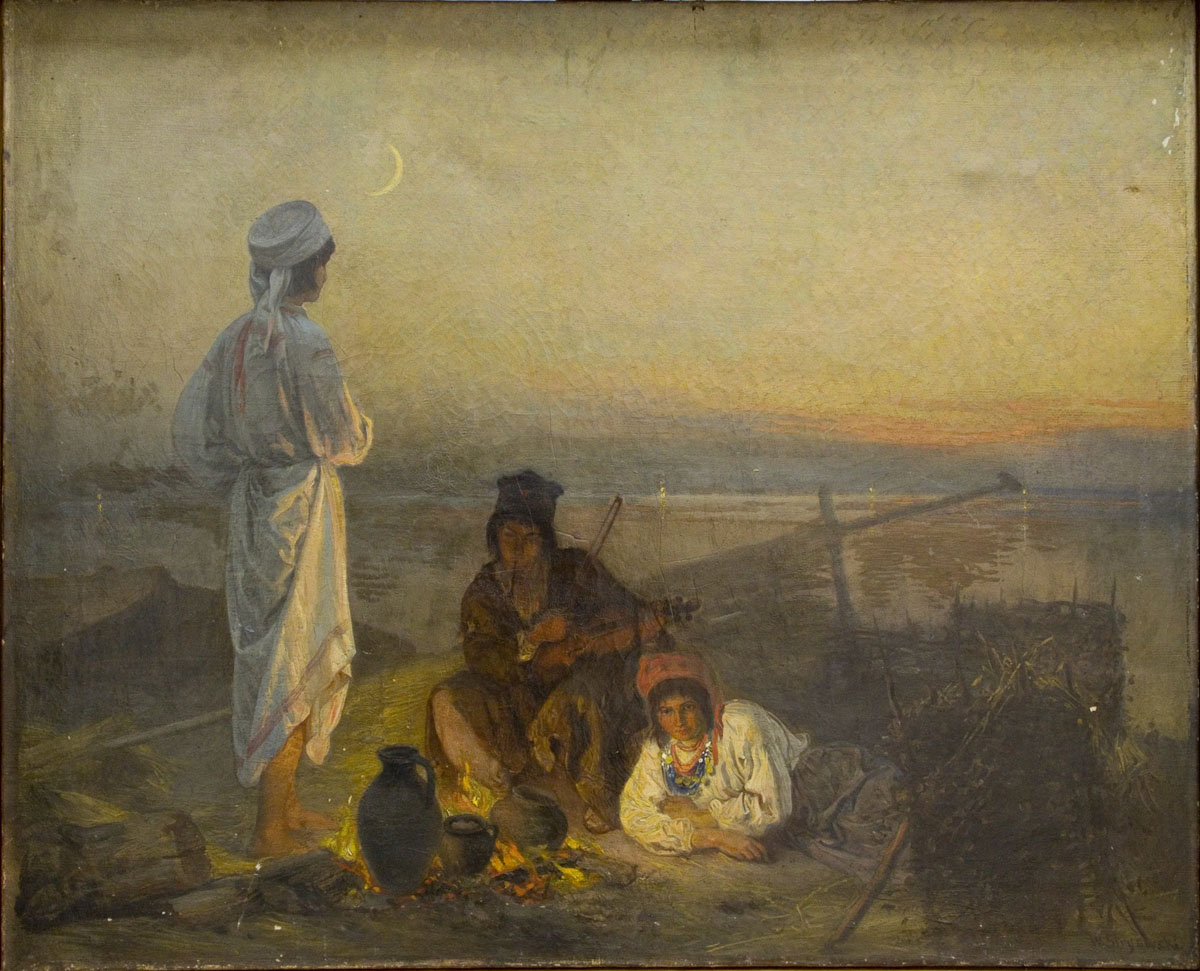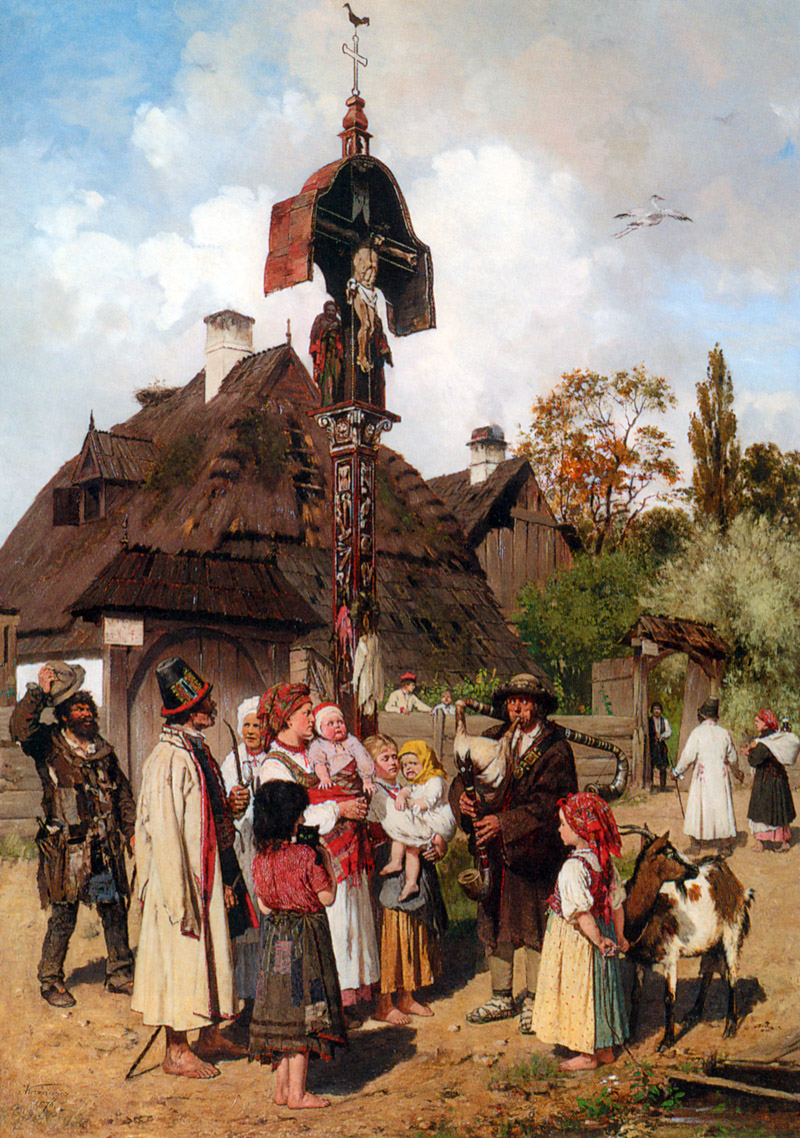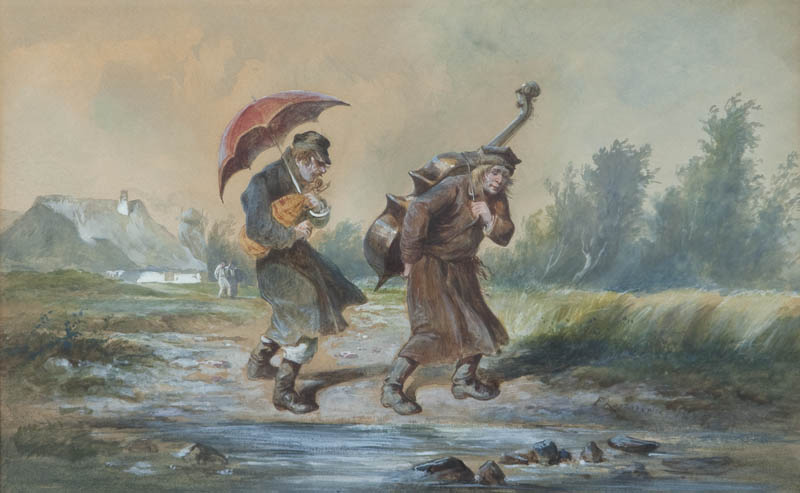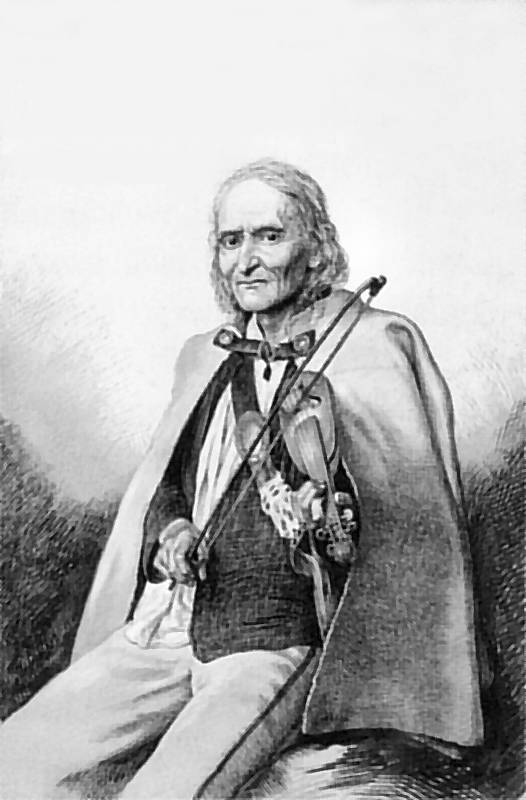Polish Folk Musicians in 10 Paintings
From a real-life 19th-century bagpiper to a literary dulcimer virtuoso and a fiddler on the... riverside. This selection of ten exceptional works shows the various incarnations of Polish folk musicians in paintings, telling the stories of their lives, their instruments and the joy they brought their audiences.
'Flisacy nad Wisłą' by Wilhelm August Stryowski
 Flisacy nad Wisłą by Wilhelm August Stryjowski, ca. 1870, photo: Mazovian Museum in Płock
Flisacy nad Wisłą by Wilhelm August Stryjowski, ca. 1870, photo: Mazovian Museum in PłockIn the old days rafting goods down the Vistula river was a key method of transportation. The rafters, often peasants, earned little and had to endure such hardships as extensive physical effort and sleeping in makeshift shanties. In return, however, their travels gave a one-of-a-kind sense of freedom linked to travelling to distant places and constantly meeting new people. When the working day was done, the rafters would often play music at their riverside camps to relax. This would sometimes draw the locals and the stop would turn into a little party with dancing and singing.
Flisacy nad Wisłą (editor’s translation: Rafters on the Vistula) created around 1870 by Wilhelm August Strykowski, a painter from Gdańsk especially valued for his depictions of rafters, is a charming portrayal of one playing his fiddle after a hard day’s work.
'Skrzypek Władek Uminic z Harendy' by Władysław Jarocki
 Skrzypek Władek Uminic z Harendy by Władysław Jarocki, 1989, photo: Culture.pl
Skrzypek Władek Uminic z Harendy by Władysław Jarocki, 1989, photo: Culture.plWładysław Jarocki, the creator of this painting, was the son-in-law of the noted poet Jan Kasprowicz. Kasprowicz, the author of the 1898 volume The Wild Rose Bush, highlighted his fascination with the nature of the Tatra Mountains. Jarocki would frequent the poet’s villa in the Harenda area of the town of Zakopane in the foothills of the mountain range, even after Kasprowicz’s death in 1926. It was most likely there, that Jarocki created this piece Skrzypek Władek Uminic z Harendy (Fiddler Władek Uminic of Harenda).
Created around 1928, the scene shows the musician enjoying a moment alone playing his instrument on a rock nearby the wooden stairs leading to the poet’s villa. Today, the villa houses the Museum of Jan Kasprowicz and an exhibition of Jarocki’s paintings and lithographs.
'Koncert Jankiela' by Maurycy Trębacz
Koncert Jankiela by Maurycy Trębacz, end of the 19th century, oil on canvas, 112 x 76 cm, photo: Wikimedia Commons/public domainKoncert Jankiela (Jankiel’s Concert) is a painting created toward the end of the 19th century (the exact date is unknown) by the Polish-Jewish historical realist painter Maurycy Trębacz. It shows Jankiel a Polish-Jewish literary hero which appeared in one of Poland’s most recognised literary works, the 1834 epic poem Sir Thaddeus (or Pan Tadeusz) by the eminent Romantic poet Adam Mickiewicz. In this poem, which shows the world of the Polish gentry during the Napoleonic era, Jankiel is the owner of an inn as well as a virtuoso of the dulcimer, a string instrument played with light sticks. In the last, joyful part of the poem a party is held and Jankiel is asked to play:
He raised his hands and lowered them together,
And smote with both hammers at once
The auditors were amazed…
All at once from many strings there burst forth a sound
As though a whole janissaries' band had become vocal with bells, cymbals and drums
'Karol Semik Dudziarz Wędrowny z Suchej' by Wojciech Gerson
 Karol Semik Dudziarz Wędrowny z Suchej by Wojciech Gerson, 1891, photo: Culture.pl
Karol Semik Dudziarz Wędrowny z Suchej by Wojciech Gerson, 1891, photo: Culture.plBack in the day, bagpipes were a popular choice of instrument among Polish folk musicians. Bagpipers would wander from place to place looking to make a living without having to work on the farm. In this 1891 watercolour by Wojciech Gerson, the celebrated representative of Academism and Realism, we see a travelling bagpiper by the name of Karol Semik whom the painter encountered in Zakopane.
Interestingly, the instrument held by the musician is made of leather covered with fur, not a common sight, as typically, bagpipes aren’t, so to say, furry. The watercolour, Travelling Bagpiper Karol Semik of Sucha, was signed by the painter with an annotation explaining that the musician had crafted the instrument himself. Apparently, Karol Semik appreciated the looks and sound of his ‘furry’ bagpipe.
'Koncert Kobziarza' by Antoni Kozakiewicz
 Koncert Kobziarza by Antoni Kozakiewicz, 1876, photo: Wikimedia Commons/public domain
Koncert Kobziarza by Antoni Kozakiewicz, 1876, photo: Wikimedia Commons/public domainIf you were wondering what a performance given by a travelling bagpiper like Karol Semik looked like, this 1876 work by the realist painter Antoni Kozakiewicz should give you an idea. Back when there was no Internet, radio or TV, the appearance of a wandering musician in a quiet village was quite an event. Even more so if the instrumentalist was good.
In this delightfully pastoral scene you can see how the curious sounds produced by the bagpiper draw and amuse the locals. Interestingly though, the painter made a mistake in the title. Koncert Kobziarza translates as ‘The Kobzar’s Concert’ whereas the depicted musician definitely isn’t a kobzar or one who plays the kobza – a kind of lute. He is clearly a bagpiper. It ought to be said though this mistake of calling a bagpipe a kobza instead of dudy (which is Polish for bagpipe) was, and still is, a popular one. But why? Apparently, it stems from the fact that commoners used to call the bagpipe a koza (‘a goat’ in Polish) which is just one letter away from kobza…
'Wędrowni Muzykanci' by Franciszek Kostrzewski
 Wędrowni Muzykanci by Franciszek Kostrzewski, 1884, photo: Wikimedia Commons/public domain
Wędrowni Muzykanci by Franciszek Kostrzewski, 1884, photo: Wikimedia Commons/public domainThe life of a travelling folk musician in the 19th century wasn’t an easy one. You were constantly looking for pay and a place to stay, with no guarantees that you’d find them at your next stop. Mind you, the earnings linked to this unsteady lifestyle typically weren’t very impressive. The difficulty of this fate is shown Franciszek Kostrzewski’s 1884 watercolour Wędrowni Muzykanci (Travelling Musicians). Two band mates, one most probably a fiddler, the other a basolia player with his instrument on his back (the basolia is a low sounding, accompanying string instrument), are on the road again. A rocky, windy path lies ahead of them.
'Zacharko Hołowaty' (Ostatni Lirnik w Mostach) by Juliusz Makarewicz
 Zacharko Hołowaty (Ostatni Lirnik w Mostach) by Julian Makarewicz, 1907, photo: National Museum in Kraków
Zacharko Hołowaty (Ostatni Lirnik w Mostach) by Julian Makarewicz, 1907, photo: National Museum in KrakówZacharko Hołowaty (Ostatni Lirnik w Mostach) (Zacharko Hołowaty [The Last Hurdy-Gurdy Player in Mosty])is an awe-inspiring 1907 portrayal of a hurdy-gurdy player by the genre and landscape painter Juliusz Makarewicz. It’s uncertain which of the villages by the name ‘Mosty’ it is referring to but it’s quite probable that it’s the one near Lviv – hurdy-gurdy players were often encountered in the once-Polish lands of today’s Ukraine. These vagabond musicians and singers enjoyed a special status: because of their knowledge of legends and mysterious ballads they were often regarded as seers.
One of the most famous hurdy-gurdy players in the Ukrainian and Polish traditions is Wernyhora, who is supposed to have lived in the 18th century. Chiefly a seer and poet to Ukrainians, Poles best remember him as the author of a prophecy saying that partitioned Poland will one day be reborn in its old borders. The prophecy was ascribed to him through literary tradition. Its oldest version (dating back to 1809 and anonymous) includes the following lines:
9. The English King and the Turks will help the entire Polish state remain in its old borders.
10. In many places in the world (…) new kingdoms will rise, the old ones will change, and there will be happiness for up to thirty years, what happens afterward I’m not allowed to say.
'Zagroda Wiejska' z Kataryniarzem by Franciszek Kostrzewski
 Zagroda Wiejska z Kataryniarzem by Franciszek Kostrzewski, 1901, photo: Culture.pl
Zagroda Wiejska z Kataryniarzem by Franciszek Kostrzewski, 1901, photo: Culture.plAnother painting by Franciszek Kostrzewski. It too shows, like The Kobzar’s Concert, the joy brought by the visit of a travelling musician. In this warm-hearted 1901 scene A Country Farmhouse with a Barrel Organ Player, the painter shows, alongside his trademark appreciation of folk themes, his love for animals.
'Jan Krzeptowski Sabała' by Walery Eljasz-Radzikowski
 Jan Krzeptowski Sabała by Walery Eljasz-Radzikowski,
Jan Krzeptowski Sabała by Walery Eljasz-Radzikowski,
photo: Culture.plWalery Eljasz-Radzikowski was a great admirer of the nature and folklore of the Tatra Mountains. As such he created numerous works inspired by the region and its culture including this 1892 watercolour entitled Jan Krzeptowski Sabała. The title is also the name of the musician who is depicted in it – he is playing the złóbcoki or a traditional, highlander mini-violin of sorts.
The charismatic Sabała was a popular character in his day, not only because of his musical talent but also due to his storytelling skills. The highlander tales, legends and anecdotes he used to tell inspired a number of Polish writers including the Nobel prize-winner Henryk Sienkiewicz. Sienkiewicz even wrote down a fairy tale of Sabała’s and published it in 1889 as Sabałowa Bajka (Sabała’s Fairy Tale). Sienkiewicz who had heard the tale from the man himself during a trip to the Tatra Mountains starts like this:
We were sitting around the fire listening to that ringing Tatra silence. It was almost time to go to rest when suddenly Sabała raised his wrinkled face, similar both to the head of an old vulture and to the face of Milton. He stared for a while into the fire with his glass eyes and started his story…
'Muzykanci Ziemi Sądeckiej' by Romuald Reguła
 Muzykanci Ziemi Sądeckiej by Romuald Reguła, 1950, photo: Culture.pl
Muzykanci Ziemi Sądeckiej by Romuald Reguła, 1950, photo: Culture.plThe earlier paintings in this selection are from the 19th or the early 20th centuries – a period when the theme of folk music was especially popular with Polish painters. To wrap things up we have a piece from a slightly later epoch, created around 1950 and entitled Muzykanci Ziemi Sądeckiej (Musicians of the Nowy Sącz Region). In this painting by Romuald Reguła, the author of numerous portraits and landscapes, we see what seems to be a highlander band in full swing. Knowing how entertaining Polish folk music can be, one can only wish that the painting could somehow convey not only the band’s looks but also its sound.
Author: Marek Kępa, Jan 18
[{"nid":"5688","uuid":"6aa9e079-0240-4dcb-9929-0d1cf55e03a5","type":"article","langcode":"en","field_event_date":"","title":"Challenges for Polish Prose in the Nineties","field_introduction":"Content: Depict the world, oneself and the form | The Mimetic Challenge: seeking the truth, destroying and creating myths | Seeking the Truth about the World | Destruction of the Heroic Emigrant Myth | Destruction of the Polish Patriot Myth | Destruction of the Flawless Democracy Myth | Creation of Myths | Biographical challenge | Challenges of genre | Summary\r\n","field_summary":"Content: Depict the world, oneself and the form | The Mimetic Challenge: seeking the truth, destroying and creating myths | Seeking the Truth about the World | Destruction of the Heroic Emigrant Myth | Destruction of the Polish Patriot Myth | Destruction of the Flawless Democracy Myth | Creation of Myths | Biographical challenge | Challenges of genre | Summary","topics_data":"a:2:{i:0;a:3:{s:3:\u0022tid\u0022;s:5:\u002259609\u0022;s:4:\u0022name\u0022;s:26:\u0022#language \u0026amp; literature\u0022;s:4:\u0022path\u0022;a:2:{s:5:\u0022alias\u0022;s:27:\u0022\/topics\/language-literature\u0022;s:8:\u0022langcode\u0022;s:2:\u0022en\u0022;}}i:1;a:3:{s:3:\u0022tid\u0022;s:5:\u002259644\u0022;s:4:\u0022name\u0022;s:8:\u0022#culture\u0022;s:4:\u0022path\u0022;a:2:{s:5:\u0022alias\u0022;s:14:\u0022\/topic\/culture\u0022;s:8:\u0022langcode\u0022;s:2:\u0022en\u0022;}}}","field_cover_display":"default","image_title":"","image_alt":"","image_360_auto":"\/sites\/default\/files\/styles\/360_auto\/public\/2018-04\/jozef_mroszczak_forum.jpg?itok=ZsoNNVXJ","image_260_auto":"\/sites\/default\/files\/styles\/260_auto_cover\/public\/2018-04\/jozef_mroszczak_forum.jpg?itok=pLlgriOu","image_560_auto":"\/sites\/default\/files\/styles\/560_auto\/public\/2018-04\/jozef_mroszczak_forum.jpg?itok=0n3ZgoL3","image_860_auto":"\/sites\/default\/files\/styles\/860_auto\/public\/2018-04\/jozef_mroszczak_forum.jpg?itok=ELffe8-z","image_1160_auto":"\/sites\/default\/files\/styles\/1160_auto\/public\/2018-04\/jozef_mroszczak_forum.jpg?itok=XazO3DM5","field_video_media":"","field_media_video_file":"","field_media_video_embed":"","field_gallery_pictures":"","field_duration":"","cover_height":"991","cover_width":"1000","cover_ratio_percent":"99.1","path":"en\/node\/5688","path_node":"\/en\/node\/5688"}]